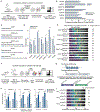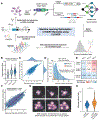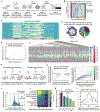Machine-learning-optimized Cas12a barcoding enables the recovery of single-cell lineages and transcriptional profiles
- PMID: 35752172
- PMCID: PMC10599400
- DOI: 10.1016/j.molcel.2022.06.001
Machine-learning-optimized Cas12a barcoding enables the recovery of single-cell lineages and transcriptional profiles
Abstract
The development of CRISPR-based barcoding methods creates an exciting opportunity to understand cellular phylogenies. We present a compact, tunable, high-capacity Cas12a barcoding system called dual acting inverted site array (DAISY). We combined high-throughput screening and machine learning to predict and optimize the 60-bp DAISY barcode sequences. After optimization, top-performing barcodes had ∼10-fold increased capacity relative to the best random-screened designs and performed reliably across diverse cell types. DAISY barcode arrays generated ∼12 bits of entropy and ∼66,000 unique barcodes. Thus, DAISY barcodes-at a fraction of the size of Cas9 barcodes-achieved high-capacity barcoding. We coupled DAISY barcoding with single-cell RNA-seq to recover lineages and gene expression profiles from ∼47,000 human melanoma cells. A single DAISY barcode recovered up to ∼700 lineages from one parental cell. This analysis revealed heritable single-cell gene expression and potential epigenetic modulation of memory gene transcription. Overall, Cas12a DAISY barcoding is an efficient tool for investigating cell-state dynamics.
Keywords: CRISPR barcoding; Cas12a; PRC2; high throughput screening; lineage tracking; machine learning; melanoma; online learning optimization; single cell genomics; transcriptional memory.
Copyright © 2022 The Author(s). Published by Elsevier Inc. All rights reserved.
Conflict of interest statement
Declaration of interests Stanford University has filed patent applications with L.C. and N.W.H. as inventors on the basis of this work. L.C. is a member of the scientific advisory board of Arbor Biotechnologies.
Figures







Similar articles
-
Defining endogenous barcoding sites for CRISPR/Cas9-based cell lineage tracing in zebrafish.J Genet Genomics. 2020 Feb 20;47(2):85-91. doi: 10.1016/j.jgg.2019.11.012. Epub 2020 Feb 7. J Genet Genomics. 2020. PMID: 32173285
-
CARLIN: A Mouse Line for Simultaneous Readout of Lineage Histories and Gene Expression.Methods Mol Biol. 2025;2886:281-298. doi: 10.1007/978-1-0716-4310-5_14. Methods Mol Biol. 2025. PMID: 39745646
-
Functionalized Lineage Tracing for the Study and Manipulation of Heterogeneous Cell Populations.Methods Mol Biol. 2022;2394:109-131. doi: 10.1007/978-1-0716-1811-0_8. Methods Mol Biol. 2022. PMID: 35094325
-
High-throughput dense reconstruction of cell lineages.Open Biol. 2019 Dec;9(12):190229. doi: 10.1098/rsob.190229. Epub 2019 Dec 11. Open Biol. 2019. PMID: 31822210 Free PMC article.
-
Cellular barcoding: lineage tracing, screening and beyond.Nat Methods. 2018 Nov;15(11):871-879. doi: 10.1038/s41592-018-0185-x. Epub 2018 Oct 30. Nat Methods. 2018. PMID: 30377352 Review.
Cited by
-
High-Throughput Identification, Modeling, and Analysis of Cancer Driver Genes In Vivo.Cold Spring Harb Perspect Med. 2023 Jul 5;13(7):a041382. doi: 10.1101/cshperspect.a041382. Cold Spring Harb Perspect Med. 2023. PMID: 37277208 Free PMC article. Review.
-
Clonal tracking in cancer and metastasis.Cancer Metastasis Rev. 2024 Jun;43(2):639-656. doi: 10.1007/s10555-023-10149-4. Epub 2023 Nov 1. Cancer Metastasis Rev. 2024. PMID: 37910295 Free PMC article. Review.
-
Advances in CRISPR-Cas9 in lineage tracing of model animals.Animal Model Exp Med. 2025 Jun;8(6):1004-1022. doi: 10.1002/ame2.70033. Epub 2025 Jun 10. Animal Model Exp Med. 2025. PMID: 40491322 Free PMC article. Review.
-
PhyloVelo enhances transcriptomic velocity field mapping using monotonically expressed genes.Nat Biotechnol. 2024 May;42(5):778-789. doi: 10.1038/s41587-023-01887-5. Epub 2023 Jul 31. Nat Biotechnol. 2024. PMID: 37524958
-
Mapping lineage-traced cells across time points with moslin.Genome Biol. 2024 Oct 21;25(1):277. doi: 10.1186/s13059-024-03422-4. Genome Biol. 2024. PMID: 39434128 Free PMC article.
References
-
- Abbasi-yadkori Y, Pál D, and Szepesvári C (2011). Improved Algorithms for Linear Stochastic Bandits. Adv. Neural Inf. Process. Syst 24.
-
- Alemany A, Florescu M, Baron CS, Peterson-Maduro J, and van Oudenaarden A (2018). Whole-organism clone tracing using single-cell sequencing. Nature 556, 108–112. - PubMed
Publication types
MeSH terms
Grants and funding
LinkOut - more resources
Full Text Sources
Research Materials

